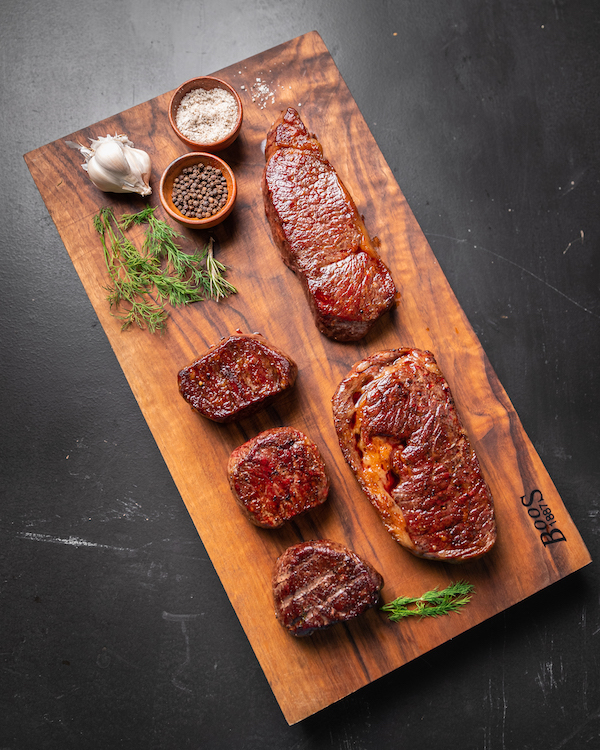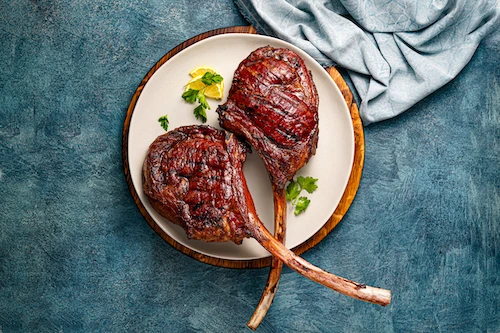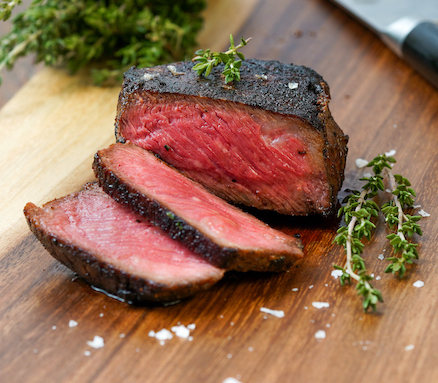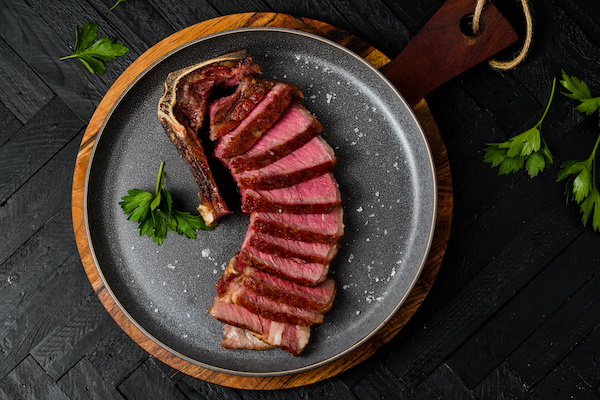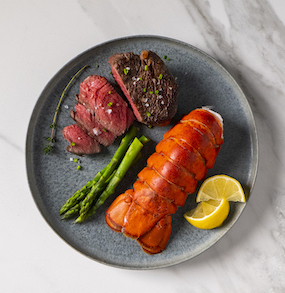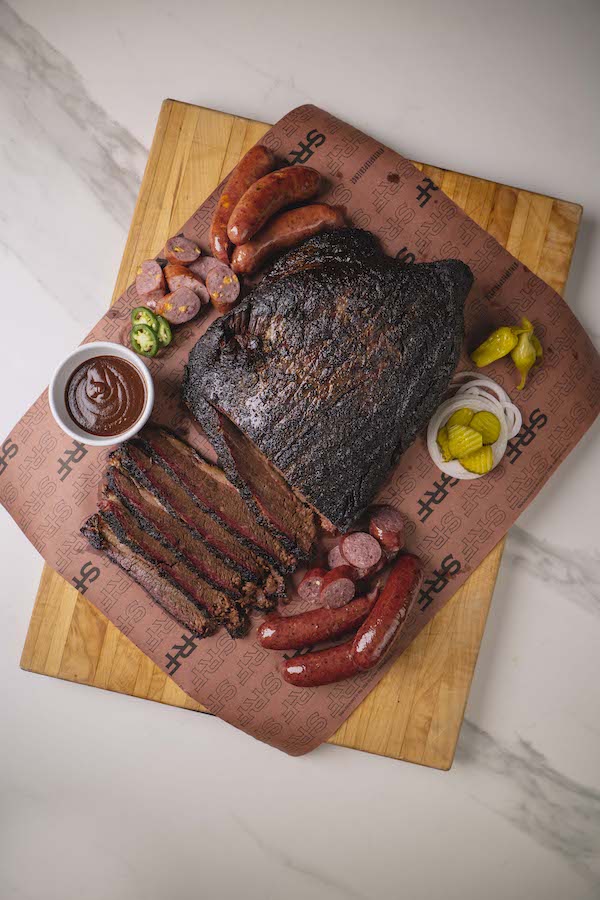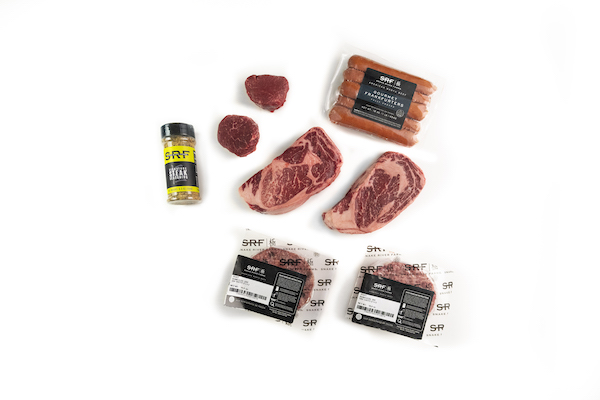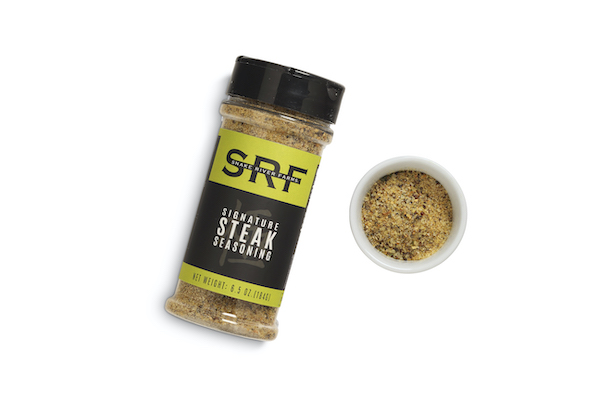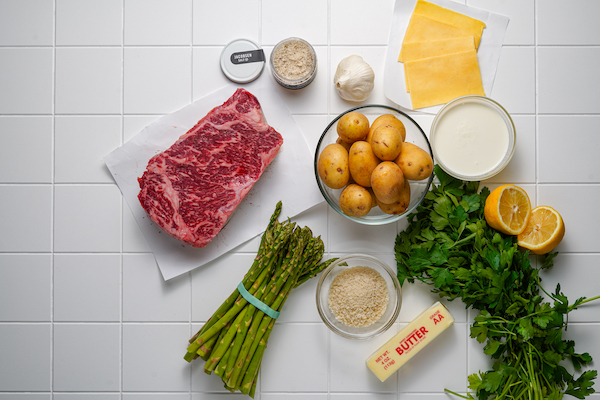Get to Know the Hanger Steak
What is the Hanger Steak?
The hanger steak is a grainy-textured elliptical-shaped muscle attached to the diaphragm and the juncture of the lumbar/thoracic vertebrae. It gets its name due to the fact it hangs from the kidney, just below the tenderloin on the inside of the hindquarters, and attaches to the last rib.
The entire piece, called the hanging tender, is cut from the plate section. The muscle is identified in the North American Meat Processors guide as NAMP 140. There is just one hanging tender per animal, which is one of the reasons it's hard to find. Once the hanging tender is trimmed, and the internal connective tissue is removed, there are two pieces called the columns. Each Snake River Farms package contains these two pieces.
Other Names for Hanger Steak
Like many butcher’s cuts, the hanger steak is also referred to by other names. The hanger steak is also known as the hanging tender, pillar, hanging tenderloin pillar, and butcher’s steak. In France you’ll find it as the onglet and in Mexico it’s sometimes called the arrachera.
Is Hanger Steak Tender?
Hanger steak is a very tender cut of beef as the muscle it is cut from is rarely stressed by the cow. When cooked to a rare or medium rare doneness, the tenderness of hanger comes through most effectively and melts in the mouth.
This is a steak with a unique and delectable flavor. Hanger steaks possess an essence similar to more marbled, and more expensive, cuts like a ribeye or New York strip. The flavor profile is rich and beefy. There is a hint of iron which makes the steak taste hearty and full.
The hanging tender has a very coarse grain that runs through the entire muscle, but when cut against this grain the result is a very tender steak.
How to Cook Hanger Steak
The hanger steak is versatile and can be quickly and easily cooked in your kitchen or outdoors on your gill. For the best results, the hanger steak should be prepared using high heat from a full bed of coals or a sizzling hot skillet. This is also a cut that shines when cooked using sous vide.
Since this unique cut is coarse and has a strong grain, it really shine when cooked to medium-rare to medium or about 125° to 130° F when doneness is measured with a meat thermometer. If you love a well done steak, this is not the cut for you. As the hanger steak reaches beyond medium, the texture gets tough and is hard to chew. On the other hand, a rare hanger steak has a very soft and loose bite that is equally undesirable.
How to Grill Hanger Steak
Any grill works, but charcoal grills, which generate higher cooking temperatures, are preferable. Regardless of the grill used, you’ll want to set it for the highest output possible.
Hanger steak grilling instructions:
- Season the hanger steak liberally with kosher salt. You can also add your favorite rub, like the Snake River Farms Steak Seasoning, or a marinade. The coarse grain of this cut holds seasonings well.
- When the grill is up to temp, place the seasoned hanger steak on the center. Sear the steak on one side for 2 to 3 minutes to achieve a good char, then flip. Since this is a cylindrical shaped cut, continue to sear all sides.
- Check the temperature in the thickest part of the steak and remove from heat when it hits 125° F for medium rare or 130° F for medium. This is the sweet spot for the hanger steak. We highly recommend not cooking this steak to rare as it does not firm up, or well done because it will get quite tough.
- Remove the steak from the grill, tent with foil and allow to rest for 5 to 10 minutes.
- Find the direction the grain runs, then use a sharp knife to cut at a 90 degree angle.
- Serve and enjoy.
How to Cook Hanger Steak in a Pan
Use a good cast iron on carbon steel pan for best results with hanger steak.
Hanger steak pan searing instructions:
- Season the steak well with salt and pepper or your favorite steak rub.
- Add a neutral vegetable oil and heat over medium high heat until the oil starts to smoke.
- Add the steak to the pan and sear on all sides so that the entire cut has a nice brown crust.
- Use a good fast read thermometer to check the temperature in the center of the thickest part of the hanger steak. remove from heat when it hits 125° F for medium rare or 130° F for medium.
- Remove from the skillet, place on a cutting board and loosely tent with foil. Allow to rest 5 to 10 minutes.
- Cut the hanger against the grain, plate and serve.
SOUS VIDE Hanger Steak
The sous vide method provides the ultimate amount of cooking control for this tender cut of beef.
Hanger steak sous vide instructions:
- Set your immersion circulator to 130° F for medium rare or 135° Ffor medium. (These temperatures are higher than for other methods, but we’ve found this produces great results.)
- Season the hanger steak with salt and pepper and seal in a freezer bag or use your food sealer.
- Place sealed bag into the sous vide tank. Allow to cook for 4 hours.
- Remove steak from the bag, place on a cutting board or rack and remove excess moisture with paper towels or clean kitchen towel. Season with salt.
- Place a cast iron or other heavy skillet on burner. Add a neutral vegetable oil and heat over medium high heat until the oil starts to smoke.
- Add the steak to the pan and sear on all sides so that the entire cut has a nice brown crust. Since the steak is already cooked, the goal is to get a savory brown crust on all surfaces as quickly as possible.
- Remove from the skillet, allow to rest for a few minutes.
- Slice against the grain and serve.
Our Favorite Hanger Steak Recipes
The hanger steak tends to be a lesser-known cut of beef, but its tenderness and delicious taste can be taken to luxurious levels when you cook with American Wagyu and choose the right recipe.
Here are a couple great recipes for wagyu hanger steak:
Where to Buy American Wagyu Hanger Steak
The hanger steak is readily available here at Snake River Farms and is an ideal cut to add to your American Wagyu cooking repertoire. It’s delicious, easy to cook and a welcome steak for just about any occasion. The rich flavor also pairs well with an herbaceous chimichurri, savory romesco or spicy Asian marinades. Give it a try. We’re sure you’ll be glad you did.

